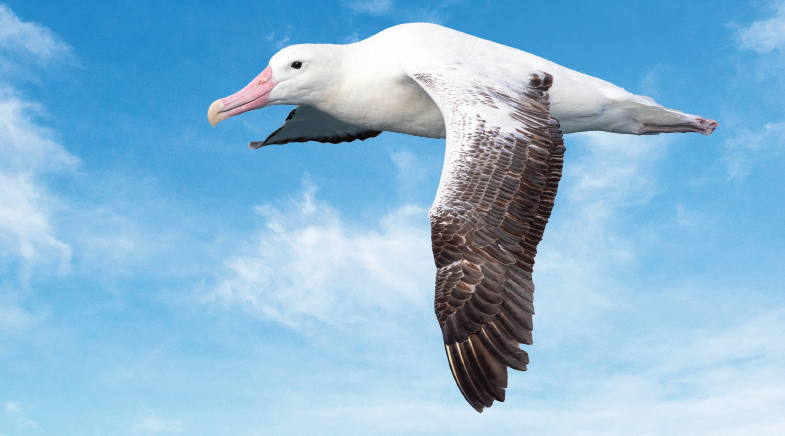The python, the godwit and you
-
- from Shaastra :: vol 04 issue 03 :: Apr 2025

The wondrous physiological adaptations that animals make demonstrate how nature's diversity works, and hold lessons for humans.
There are three kinds of people: the sprinter, the endurance athlete, and the rest. Today's media is full of advice to the rest of us about many health matters, including our hearts. The sensible parts of this advice relate to diet, lifestyle and exercise. By and large, the young ignore this advice, and the older ones note it down diligently on January 1 as part of their resolutions for the year. Until there is a crisis. We then briefly become diligent followers of one or the other lifestyle gurus.
During a sprint, the human heart undergoes acute physiological changes to meet the extreme demands on the body. These cardiac responses reflect the unique nature of high-intensity, short-duration exercise. When an athlete begins sprinting, the heart rate increases rapidly to supply the sudden oxygen demand to working muscles. Interestingly, research on elite sprinters shows that the heart rate doesn't peak during the sprint itself but continues to rise for approximately 12 seconds after the completion of the sprint, reaching about 110% of the end-point heart rate. Blood pressure increases acutely during sprinting to ensure adequate perfusion of working muscles. After repeated sprint tests, ace athletes recover approximately 35-40 heartbeats within the first minute post-exercise, reflecting the significant cardiovascular strain induced by maximal sprint efforts and the ability of the ultra-fit to recover.
While we may be dismayed at the low likelihood of becoming regular sprinters who exercise their cardiovascular systems, many of us strain this system in other ways, not always wisely. Periodic gorging at office 'free' lunches, weddings, and the like requires our hearts and circulatory systems to act quickly. Akin to sprinting, except here, the gut is doing the sprinting. After consuming a meal, our metabolism briefly speeds up as the body attempts to process the additional calories, which can cause sensations of feeling hot, sweaty, or occasionally dizzy. Unlike in sprinting, where blood is diverted to help power our skeletal muscles, in gorging, blood is diverted to the digestive system and away from other body areas, and the heart rate temporarily increases to maintain blood pressure. In older adults or those with autonomic disorders, these mechanisms may be inadequate, leading to postprandial hypotension or lowered blood pressure.
FASTING AND FEASTING
Both sprinters and gourmands have something to learn from the Burmese (and other) pythons. Like teenagers coming home for vacation from college, pythons sleep, eat vociferously and become comatose again. The Burmese python (Python bivittatus) and related python species exhibit one of the most extreme examples of metabolic regulation in the vertebrate world. These remarkable reptiles can survive extended fasting periods and then consume enormous meals, triggering dramatic physiological transformations throughout their bodies. During extended fasting periods, pythons enter a significant metabolic depression, dramatically downregulating physiological functions to conserve energy. This represents an evolutionary adaptation to their infrequent feeding ecology in the wild, where prey availability may be unpredictable and sporadic. The fasting python's cardiovascular system reflects this reduced metabolic state. The heart maintains minimal function, with lower cardiac mass and reduced energy expenditure. The python's exceptional capacity to downregulate metabolism during fasting periods creates a physiological baseline from which the dramatic post-feeding changes can be understood.
A monthly column that explores themes on nature, nurture and neighbourhood in the shaping of form and function.
When a python consumes a meal, it undergoes one of the most extreme metabolic responses documented in vertebrates. Pythons can consume prey items equivalent to 25% of their body mass and in some cases, exceeding 100% of their body mass. Fortunately, even hungry teenagers do not do this. This massive meal triggers an explosion in metabolic rate that peaks at about 20-40 times the fasting level, depending on the species and meal size. This metabolic intensity rivals that of sprinting mammals, but is sustained for days rather than minutes or hours.
Oxygen consumption dramatically increases to fuel this metabolic surge, peaking at 1-3 days post-feeding. A lot of the energy in the food goes to fuel digestion. The metabolic cost of digestion is substantial, estimated at approximately 30% of the meal's total energy yield. This elevated metabolic state gradually returns to baseline over 6-8 days as the process of digestion is completed. The python's ability to rapidly upregulate its metabolism represents an extraordinary adaptation to efficiently process these massive, infrequent meals.

The python's heart undergoes substantial metabolic reprogramming to support its increased workload during digestion. After a meal, cardiac energy production increases significantly. Interestingly, while energy demand increases, the heart prefers to use fatty acids rather than glucose. The python's heart's ability to efficiently utilise fatty acids allows it to capitalise on the nutrient profile resulting from protein-rich meals. This metabolic flexibility represents a crucial adaptation supporting the heart's increased workload, as heart rates nearly double after feeding.
The most remarkable aspect of the python's postprandial adaptations is their complete reversibility. All physiological changes — from increased metabolic rate to organ growth and molecular adaptations — return to fasting baseline levels within one or two weeks after feeding, coinciding with the completion of digestion. The heart reverts to its fasting size through regulated tissue regression. This bidirectional plasticity represents an extraordinary adaptation that allows pythons to digest massive meals efficiently while minimising energy expenditure during fasting periods.
IN THE LONG RUN
If bursts of activity — sprinting and gorging in humans or pythons — trigger significant changes in metabolism, cardiac function and the circulatory system, so does endurance running. Olympic long-distance runners represent the pinnacle of human endurance capability, with their cardiovascular systems undergoing remarkable adaptations to sustain prolonged high-intensity exercise. Olympic-level endurance runners develop distinctive cardiac adaptations characterised by significant structural remodelling of the heart. More than half of these elite athletes demonstrate 'eccentric' cardiac remodelling compared to sprinters who predominantly maintain normal cardiac geometry. The cardiac output of trained endurance athletes may increase dramatically from 5-6 litres/min for normal people at rest to approximately 40 litres/min during maximal exercise. Following intense long-distance racing, cardiac function generally returns to baseline within a predictable timeframe. Most research indicates that functional cardiac changes resolve within 24 hours to 7 days after competition.
In October 2022, a juvenile bar-tailed godwit completed a 13,560-km non-stop flight from Alaska to Tasmania!
If our undergraduate on vacation is no patch on the python, our endurance athletes are no match for the godwit. The bar-tailed godwit (Limosa lapponica) has earned its place in biological history as one of nature's most extraordinary long-distance migrants. The bar-tailed godwit holds the world record for the longest non-stop migration by any bird. In October 2022, a juvenile bar-tailed godwit known by its tag number '234684' completed an astonishing 13,560-kilometre non-stop flight from Alaska to Tasmania. This epic journey lasted 11 days and one hour without landing once. The round-trip migration for the subspecies Limosa lapponica baueri is over 29,000 kilometres. These godwits breed in Alaska during the northern summer and then migrate to New Zealand, where they spend about six months replenishing their fat reserves before flying back to Alaska for the next breeding season.

The godwit's ability to undertake such extreme endurance flights is the result of remarkable physiological adaptations that occur before and during migration. Before embarking on their long-distance migration, godwits undergo extensive physiological changes to prepare their bodies for the journey. The average godwit normally weighs about 300 grams, but after fuelling up for the trip, they weigh approximately 600 grams — effectively doubling their weight in fat. By the time they depart, over half their body weight consists of fat, their biological equivalent of jet fuel. These birds gorge on worms, clams, and crustaceans during their pre-migration fuelling period. This intense feeding builds up fat layers under their skin that can reach up to an inch thick, with additional fat accumulating around their organs.

Perhaps the most fascinating aspect of the godwit's migration preparation is the strategic reorganisation of its internal organs. The heart and flight muscles are relatively larger in flying godwits compared to fuelling birds, reflecting their critical role in supporting endurance flight. During their non-stop flights, godwits may burn through more than half of their body weight. As they get lighter, their muscles don't need to work as hard, which helps conserve energy for the remainder of the journey. They can also boost the size of their chest muscles and heart while flying to aid the distribution of energy and oxygen. Godwits fly at approximately 55-60 km/h during transoceanic journeys. They maintain an estimated metabolic rate of 8-10 times their basal metabolic rate for more than nine days, representing a combination of metabolic intensity and duration unprecedented in the literature on animal energetics. The energy expenditure during flight is not uniform throughout the journey. The rate of fuel burn is greatest during the launch and climb phases of the flight, making takeoff and ascending to flight altitude particularly energy-intensive. This explains why godwits are unlikely to stop during migration unless forced to by diminishing fuel or adverse weather conditions: the energy cost of taking off again would be substantial.
HEIGHTS OF ENDURANCE
The Tanguar Haor in northeastern Bangladesh serves as another significant habitat for godwits, particularly the black-tailed variety. This large wetland system has been the focus of research efforts to track godwit movements, with scientists deploying satellite transmitters on birds captured at this location. Recent tracking studies have provided unprecedented insights into these journeys. Perhaps most remarkably, tracking data has confirmed that Bangladeshi godwits undertake trans-Himalayan migrations, crossing one of the world's most formidable mountain ranges on their journeys to and from breeding grounds. This represents an extraordinary feat of endurance and navigation.
The godwits' migration raises fascinating questions about the evolutionary adaptations that make their long journeys possible.
Scientific understanding of godwits in Bangladesh continues to advance through the dedicated research efforts of Delip K. Das from Jagannath University in Dhaka, Bangladesh, who has been conducting vital work tracking black-tailed godwits, having attached satellite transmitters to 20 birds captured in Tanguar Haor and coastal areas. This research forms part of his doctoral thesis at the University of Groningen in the Netherlands, where he investigates why black-tailed godwits choose to spend winters in different ecosystems of Bangladesh. Additionally, collaborative work described in a short documentary titled Delta Sentinels (bit.ly/delta-sentinels) showcases the challenging fieldwork in studying godwits in the world's largest river delta.
The godwit's migratory flight represents one of nature's most extraordinary feats of endurance. Through remarkable physiological adaptations — including strategic organ resizing, massive fat loading, metabolic adjustments, and possibly unique sleep patterns — these birds can fly non-stop for more than 13,000 kilometres across the open ocean. Their migration pushes the boundaries of what we know about avian physiology and raises fascinating questions about the limits of animal endurance and the evolutionary adaptations that make such journeys possible.
There were two kinds of biologists: those who peer at what's under a microscope and those who look around us; they barely communicated with each other. A third kind, which studies the physiology of diverse animals and plants, not only illustrates how nature's wondrous diversity works but also shows us humans to be a small component of the scale of physiological adaptations that is possible.
Also Read:
Marshall, L. 'Leslie Leinwand & The Science of Getting Things Done' (2024). bit.ly/leslie-leinwand
Have a
story idea?
Tell us.
Do you have a recent research paper or an idea for a science/technology-themed article that you'd like to tell us about?
GET IN TOUCH















